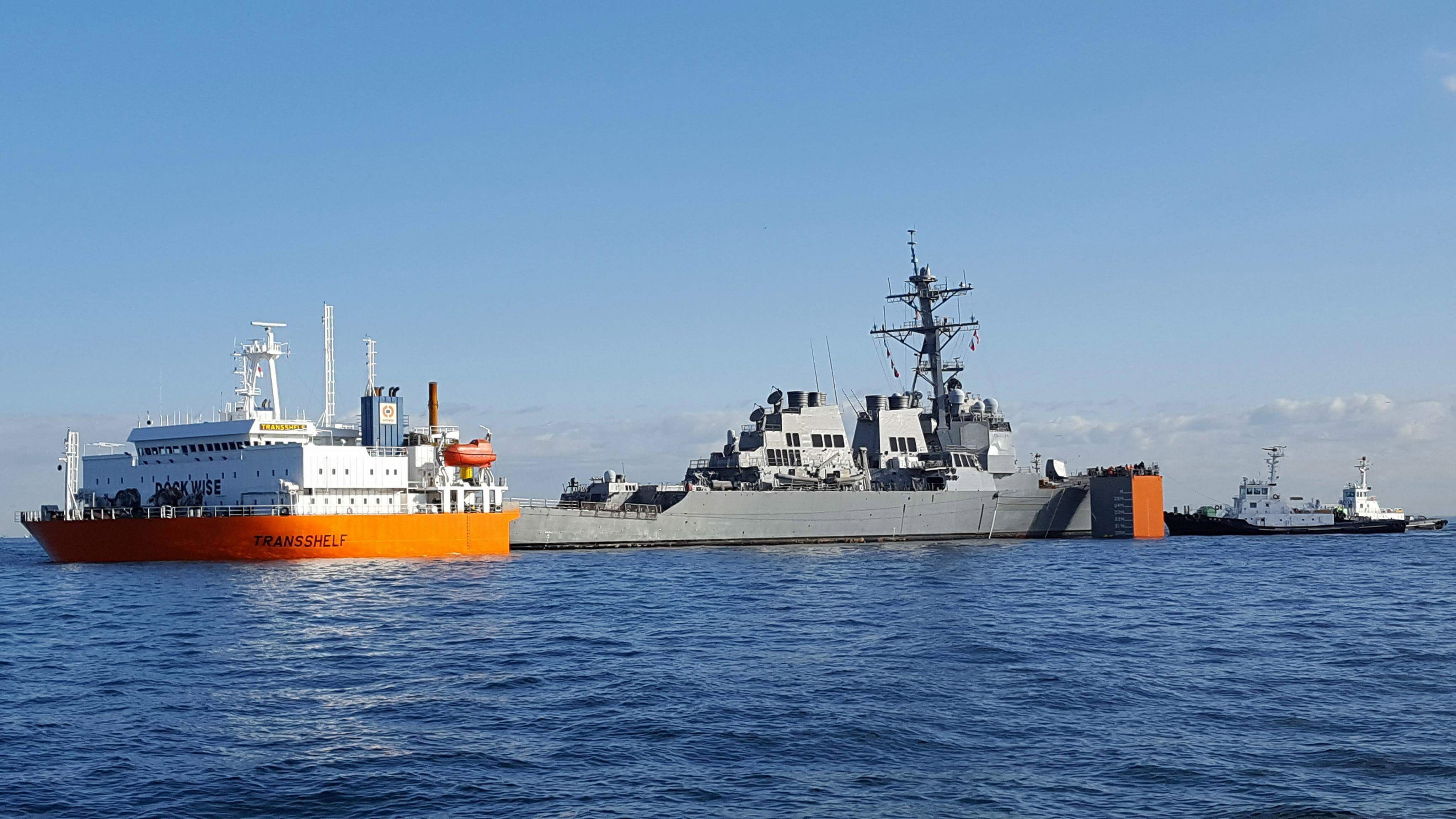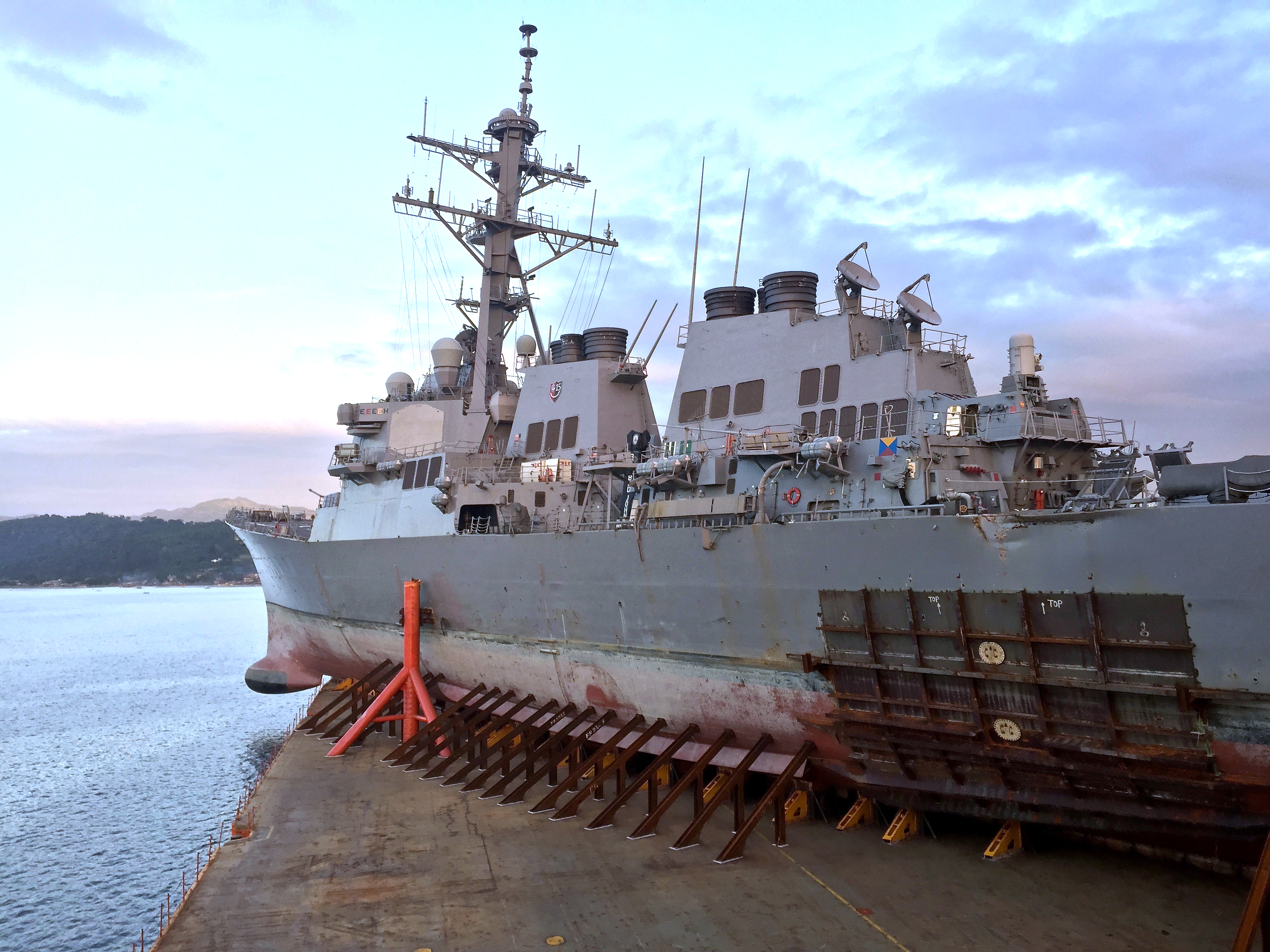
This post was updated to correct circumstances of a Jan. 31, 2017 incident involving the guided-missile cruiser USS Antietam (CG-54). The ship suffered a grounding, not a collision.
U.S. warships in the Western Pacific were overtasked and starved for manpower ahead of two fatal collisions that killed 17 sailors, the former commander of Japan-based U.S. 7th Fleet wrote in his first public comments since being removed from his position last year.
Recently retired Vice Adm. Joseph Aucoin laid out a case that problems found in the Navy’s Forward Deployed Naval Forces in Japan (FNDF-J) that surrounded the collisions of USS Fitzgerald (DDG-62) and USS John S. McCain (DDG-56) were systemic across the entire Navy.
“In some quarters, these collisions are viewed and characterized as a ‘local’—Japan only—problem. There certainly were pressures on the fleet in Japan, but there are also indications of problems elsewhere. While the investigations in the aftermath of the loss of 17 sailors addressed many of the issues that may have led to the collisions, there were other factors,” Aucoin wrote in U.S. Naval Institute’s Proceedings Today.
“Without a full understanding of what happened, we will be limited in our ability to address the root causes and ensure this does not happen again.”
Sailors under his command were worked hard over years of unplanned taskings from U.S. Pacific Fleet, he wrote, and his command’s manning needs were ranked below U.S.-based ships that fell under U.S. Fleet Forces’ Optimized Fleet Response Plan.

Aucoin also wrote that the subsequent investigations into the problems in the U.S. surface fleet – the Comprehensive Review led by Fleet Forces Commander Adm. Phil Davidson and the Strategic Readiness Review directed by Secretary of the Navy Richard V. Spencer – left out key information in understanding the manning, training and maintenance problems in 7th Fleet. Aucoin said he was not interviewed as part of the Davidson or SECNAV investigations after he was removed from command shortly after the McCain collision in August.
Aucoin declined to comment further when reached by USNI News on Thursday.
In the piece, Aucoin said the Fleet Forces-created OFRP manning concept that was designed to create a predictable deployment schedule for U.S.-based carrier strike groups took away qualified sailors from FDNF-J and forced the units in 7th Fleet to trade qualified sailors between ships – also known as cross-decking.
“This short-sighted mandate would enable CONUS-based units to be fully manned to their fit/fill thresholds starting from the beginning of their 36-month cycle, but the negative consequence was that non-OFRP units, such as the FDNF, would bear the brunt of the shortfall,” he wrote.
“It was frustrating to hear that some San Diego ships were overmanned, as I expressed during one PACFLT meeting after hearing a West Coast ship was so over-manned it left 30 people on the pier. At the time, we were having to cross-deck 49 sailors in FDNF-J to fill gaps on our ships.”
The bridge crew on watch on McCain when it collided with a merchant chemical tanker off Singapore in August was cross-decked from cruiser USS Antietam (CG-54), which was laid up after a grounding earlier in the year, though the subsequent investigations found the sailors weren’t qualified to stand watch on the bridge of McCain.
A spokesman for U.S. Fleet Forces acknowledged a Thursday afternoon USNI News request for comment but did not immediately respond to questions.
As 7th Fleet manning decreased, Aucoin wrote, demands for surface forces from U.S Pacific Fleet increased.

He routinely pushed back against orders to send ships on missions instead of allowing them to carry out their required training. The response he received from his Pacific Fleet, led by Adm. Scott Swift, and Fleet Forces, was to provide more information on why a mission should be delayed, before ultimately being ordered to carry on with the mission, he said
“Such responses always were required to be accompanied with a by-name identified ship to be used if we were ‘forced to source’ the mission, as well as an estimated impact statement of what cost and risks would be incurred if we were to task that ship with the mission. The impact statements routinely highlighted to higher headquarters that sourcing these missions would come at the cost of training and readiness. More often than not, we would be directed to fill and execute the mission through a follow-on task order or voice order directing the by-name identified ship to execute the mission. In a few cases, we were able to argue for changes that allowed ships to complete training or maintenance. In many other cases, our arguments and recommendations were either overruled or ignored,” Aucoin writes.
Aucoin said manning shortages diminished his command’s ability to adequately carry out missions, but he wrote that he repeatedly informed his superiors of the problem well before the 2017 collisions.
When contacted by USNI News, a spokesman for Pacific Fleet said the command didn’t have any additional information to add beyond that contained in numerous investigations into the collisions.
“There have been several investigations and reviews into the circumstances leading up to the collisions last year,” Capt. Charlie Brown with Pacific Fleet told USNI News on Tuesday.
“There also have been investigations into the collisions by organizations outside the U.S. Navy. We do not have anything to add to these numerous reviews and investigation.”
Aucoin’s concerns about manning were also reported in a Navy Inspector General report, which was based on a series of interviews with leadership in Japan and site visits to Japan between March 13 and 31, 2017. The report was released June 16, 2017. USS Fitzgerald (DDG-62) collided with a container ship before dawn on June 17.
The Inspector General report found, “Sailors are routinely cross-decked amongst ships within the Strike Group or placed on operational holds (OPHOLDs). While cross-decking fixes the immediate problem, it masks underlying causes such as overseas screening challenges and manning shortages of experienced sailors with the requisite skillsets. This places the burden on existing Sailors already enduring a high OPTEMPO environment during peacetime. Moreover, current detailing processes routinely issues orders with short lead times; this compounds OPHOLD and cross-decking challenges as units attempt to mitigate billet gaps when prospective gains with near-term arrival dates fail to meet overseas screening requirements.”





